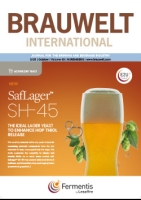Chlorine dioxide has proven to be an effective disinfectant for fighting undesired microorganisms in drinking water and processing water. Disinfection using chlorine dioxide also protects piping and surfaces against biofilm growth at very low concentration.
This contribution would like to draw attention to a fundamental change in application technology for cleaning up the water system as well as maintaining cleanliness and disinfection of machines and plants in the beverage industry. An Imeca® decontron plant has been in operation in Stiegl Brewery in Salzburg since March 2006. A year of commercial operation has confirmed the results that were presented in an earlier Brauwelt edition.
Chlorine dioxide is the most preferable disinfectant under the conditions of CIP cleaning. It is easily biologicaly degradable and has no ecologically critical byproducts. Broad clinical research has shown that there are no hazards neither for human beings nor animals caused by chlorine dioxide in its application concentrations. Using the DuoSept System, economic, ecologic and microbiological benefits could be proved in numerous bottling plants.
For some time, returnable goods have been at the centre of discussion by society at large. The focus is on aspects of process ecology, i.e. protection of the environment and resources. Extensive consideration has also been given to the economics of the returnable loop. The condition of stacking crates has, in the first instance, a major influence on safety in beverage operations and in the logistics chain. And there is also the risk of injuries to consumers due to defective crates.
Beer quality, in particular taste stability, is substantially influenced by oxygen pick-up during the production process. Numerous technological measures are taken to minimise pick-up. Also in pitching technology for large vessels, the doubling process, optimisation potential exists resulting from varying aeration and yeast addition operations.
The new KHS Innoclean SEC bottle washing machine provides outstanding cleaning results alongside ecological and economic advantages. The machine is compact in design and also fits easily into existing line equipment when substituting individual machines.
In the fermentation and beverage industries, plants are cleaned regularly using a CIP process in circulation. CIP cleaning can be done both as a stock cleaning process as well as a “run-to-waste” process. Both systems have advantages and disadvantages that will be explained below.
Unless agreed otherwise,
Horizontal and vertical cylindroconical tanks have become widely accepted during the past 40 years, both from a production point of view as well as in terms of acceptance by beer consumers. In order to guarantee production of high quality beers, scientists developed a series of quality criteria for cylindroconical tanks. This article addresses these tank criteria. Part 1 deals with tank and cooling surface sizing and Part 2, in a subsequent issue of Brauwelt International, will deal with enclosures of tanks.
The disinfectant of U. Grajecki GmbH & Co. KG, subjected to repeated development over the past eleven years to meet the requirements of the beverage industry, is storable and can be conductivity controlled. This contribution describes the various applications, especially under the aspect of biofilm detachment, and underlines its advantages by providing test data.
Peroxyacetic acid is mostly abbreviated as peracetic acid (PAA) and known in chemical science for only about 100 years. After discovery of the “equilibrium mixture”, PAA developed into a secure, economic, and ecologically safe disinfection agent for the food industry. Ecolab Deutschland GmbH further developed its P3-oxysan range, the efficacy and mode of action of which is explained in the following.


